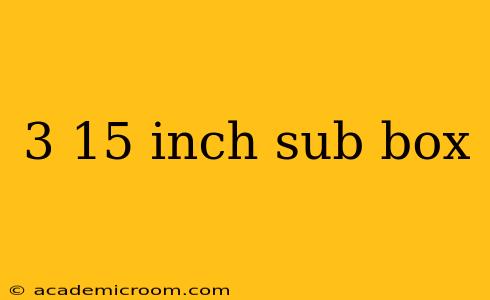Building a box for three 15-inch subwoofers is a significant undertaking, demanding careful planning and execution to achieve optimal performance. This guide will delve into the crucial considerations, helping you design and build a high-quality enclosure that maximizes your audio system's potential. We'll explore various design options, crucial calculations, and practical tips for a successful project.
What are the Different Types of 3 15-Inch Subwoofer Box Designs?
Several enclosure types can accommodate three 15-inch subwoofers. The best choice depends on your desired sound characteristics and available space. Here are the most common:
-
Sealed (Acoustic Suspension): Sealed enclosures are known for their tight, accurate bass reproduction and relatively small size. They provide excellent transient response, meaning the bass notes start and stop cleanly. However, they generally offer less overall output than ported designs.
-
Ported (Bass Reflex): Ported enclosures use a port (tube) to augment bass output at a specific frequency. This design is capable of significantly greater output than a sealed enclosure, particularly in the low-frequency range. However, they require more careful design to avoid unwanted resonances and may exhibit less transient response.
-
Bandpass: Bandpass enclosures are more complex, using two chambers and tuned ports to produce bass in a specific frequency range. They can deliver extremely high output levels within their tuned frequency band but are challenging to design and build correctly.
-
Horn: Horn-loaded subwoofers provide high efficiency and tremendous output but demand extensive space and meticulous construction. This design is often favored in professional sound systems.
What Size Box Do I Need for Three 15-Inch Subwoofers?
There's no single "correct" size. The ideal volume depends on the subwoofer's specifications (found in the manufacturer's documentation), the chosen enclosure type, and your desired sound. Each subwoofer will need its own individual chamber in a multi-subwoofer enclosure; simply adding up the volumes for individual subwoofers isn't accurate.
How Do I Calculate the Correct Box Volume for My Subwoofers?
Accurate calculations are critical. Software programs like WinISD are commonly used to model subwoofer performance in different enclosure types. These programs require the subwoofer's Thiele/Small parameters (TS parameters) – crucial values defining the driver's behavior. The TS parameters are often provided by the manufacturer, usually in the product specifications. These parameters are crucial for accurately calculating the necessary internal volume of the enclosure, the port dimensions (for ported designs), and predicting the resulting frequency response. Improper calculations can lead to poor sound quality, reduced output, or even damage to the subwoofer.
What Materials Are Best for a 3 15-Inch Subwoofer Box?
Durability and stiffness are essential. Common choices include:
-
Medium-density fiberboard (MDF): MDF is a popular choice due to its density, stiffness, and relative affordability. Thicker panels (at least ¾ inch or even 1 inch) are recommended for 15-inch subwoofers to minimize resonance.
-
Birch plywood: Plywood offers excellent stiffness and can be a superior choice but is typically more expensive.
Proper bracing within the enclosure is also crucial to minimize vibrations and ensure structural integrity, particularly with larger, more powerful subwoofers.
What Kind of Ports Should I Use for a Ported 3 15-Inch Subwoofer Box?
The port's dimensions (length and diameter) significantly impact the tuning frequency of a ported enclosure. Again, WinISD or similar software helps determine the optimal port dimensions based on your subwoofer's parameters and the desired tuning frequency. Common port types include:
- Circular ports: Relatively easy to construct, offering good airflow.
- Slot ports: Can be more efficient in some designs, potentially allowing for a smaller overall box size.
Properly cut and finished ports are vital to minimize turbulence and noise.
How Much Will a 3 15-Inch Subwoofer Box Cost?
The cost depends on the materials used, the complexity of the design, and your labor costs. MDF is more budget-friendly than plywood. The cost of the subwoofer units themselves will also be a considerable factor. You'll need to budget for MDF or plywood sheets, wood glue, screws, bracing material, port tubing (if applicable), sealant, paint or veneer, and any other finishing materials. If you are not building the enclosure yourself, professional fabrication services will add substantially to the overall cost.
This guide offers a foundational understanding. Consult with audio professionals or experienced DIY builders for personalized guidance tailored to your specific subwoofers and desired sound. Remember, careful planning and precise execution are essential for a successful 3 15-inch subwoofer box project.
